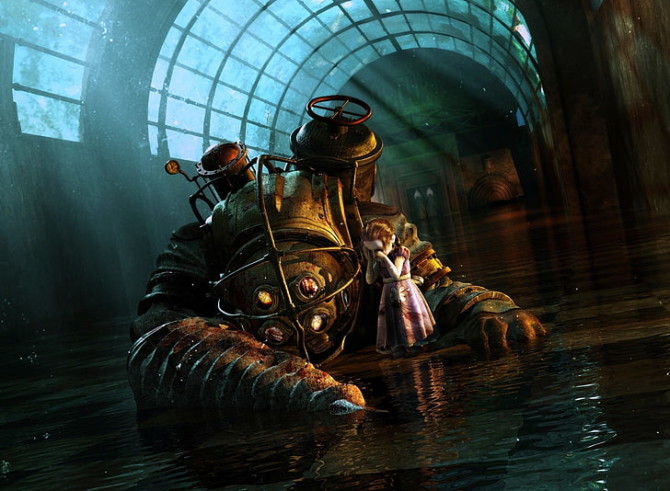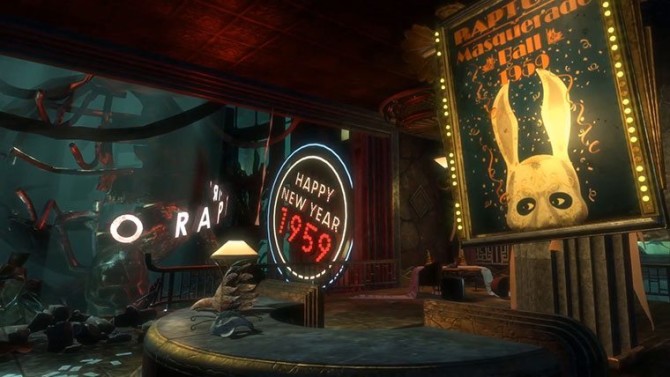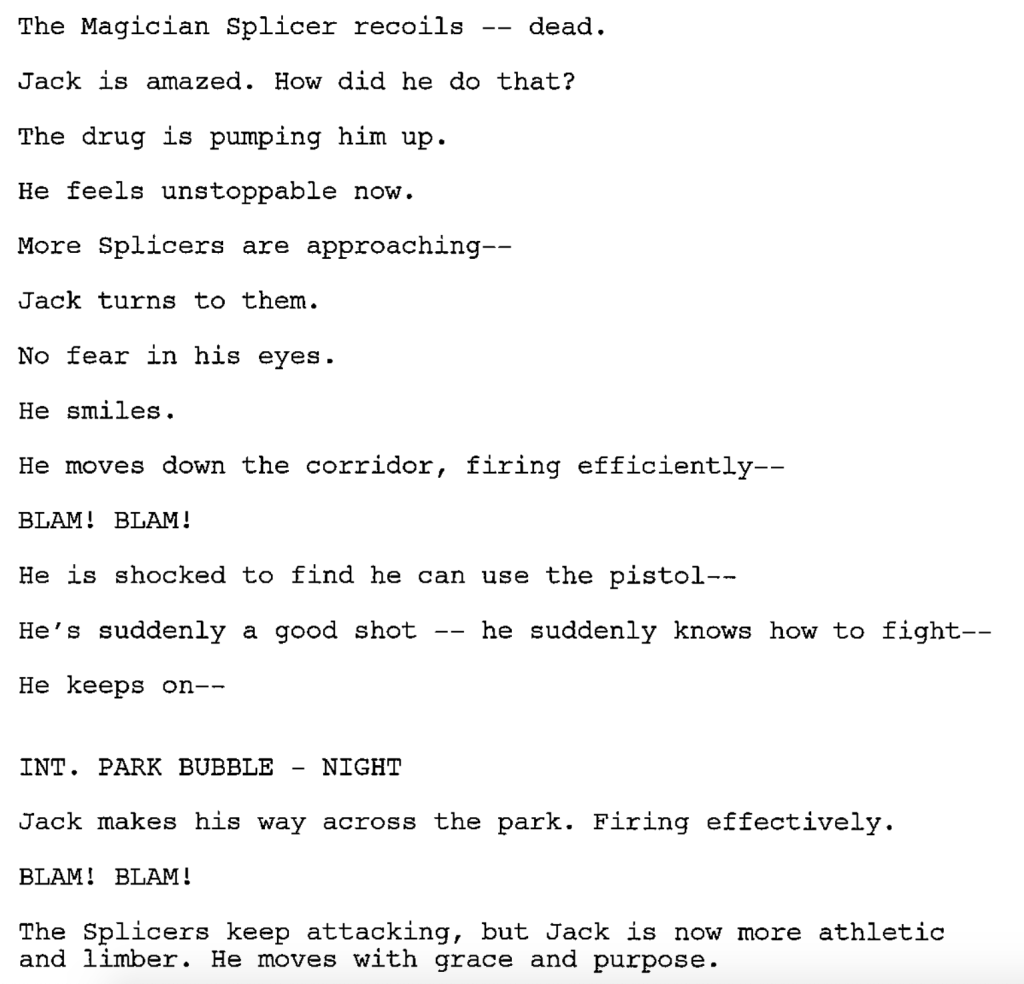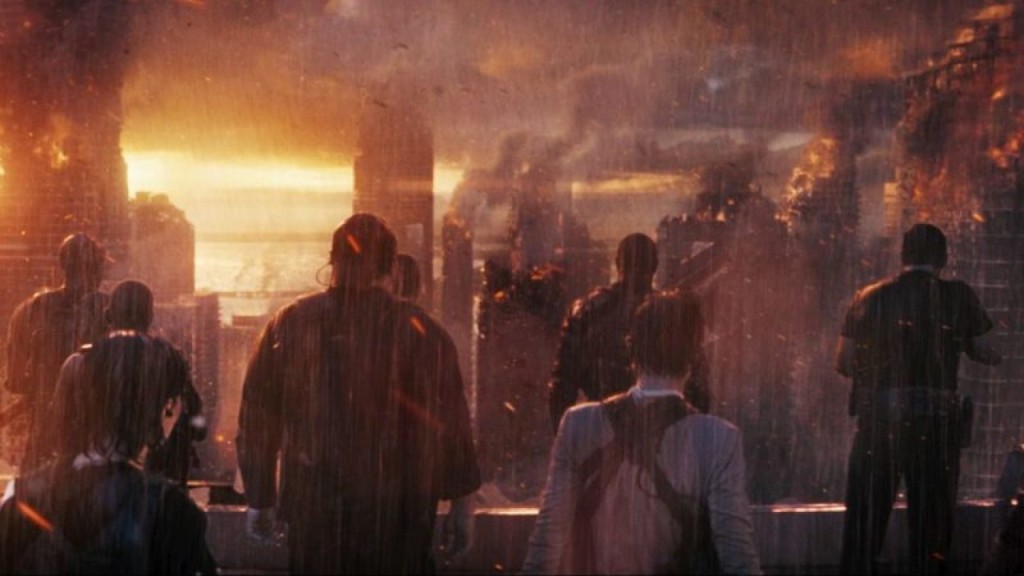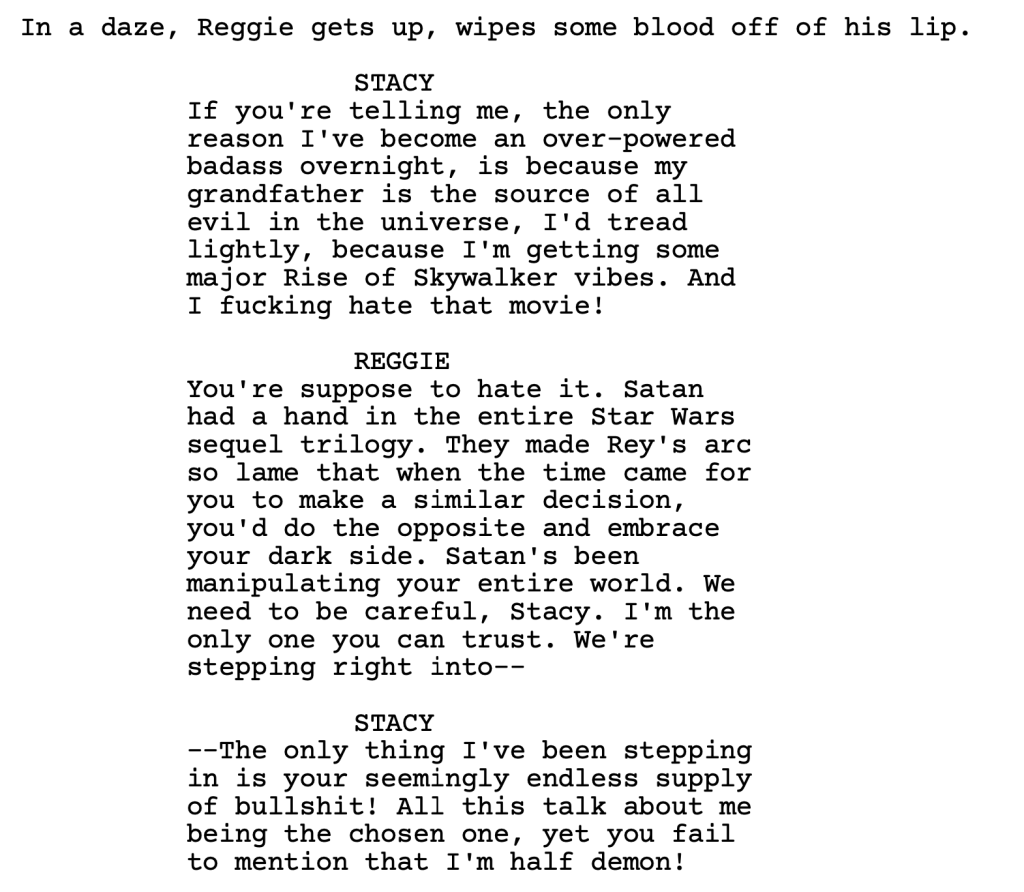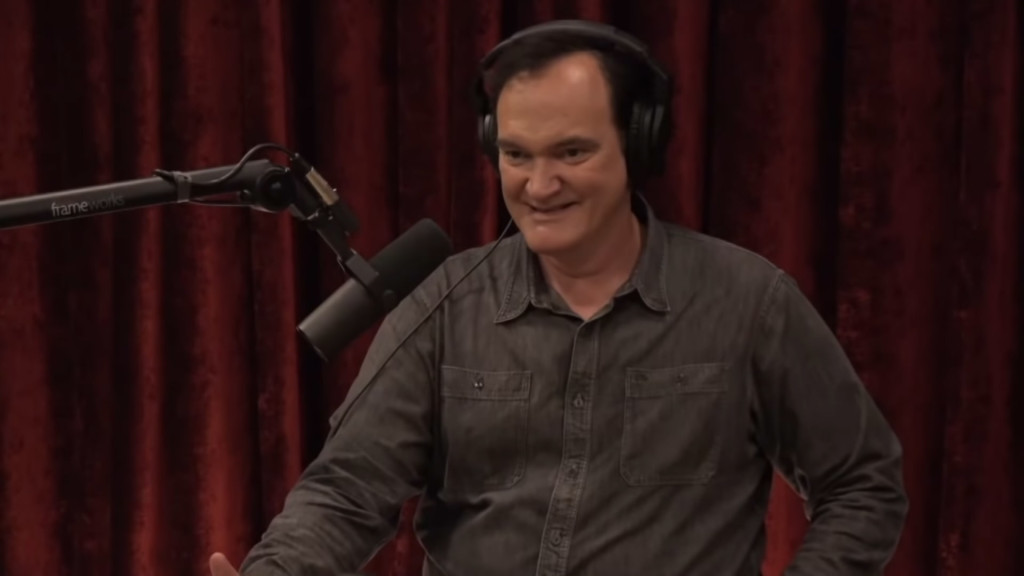Genre: Sci-Fi/Horror
Premise: After his plane crashes, a man finds himself stuck in a giant deserted 1950s city at the bottom of the ocean.
About: Bioshock was heading towards production a decade ago when, just weeks before shooting started, it was cancelled. But according to lore, it was not cancelled because they couldn’t get the script right. It was cancelled because the studio got nervous about a 200 million dollar R-rated film, particularly when there had been so many high profile video game adaptation failures recently. For all intents and purposes, the script might have been great. You think that with content hungry streamers desperate to find the next big thing, Bioshock is going to find a home at some point, likely as a series.
Writer: John Logan (Gore Verbinski was set to direct)
Details: 111 pages
I’m trying to inspire you guys with some A-grade sci-fi world-building here.
John Logan is a fascinating screenwriter. He’s credited with over a dozen high profile studio movies (Skyfall, Alien: Covenant, Hugo, Sweeney Todd, The Aviator, The Last Samurai, Star Trek: Nemesis, The Time Machine, etc.). Yet he doesn’t have a single movie that you actually remember and want to revisit (with the exception of, maybe, Gladiator). In many ways, he’s the ultimate studio screenwriter. And what I’m going to try and do today is figure out what John Logan does to be so perfectly suited to write big budget studio movies.
Let’s take a look.
The opening to Bioshock is basically the opening to The Graduate. So much so that they might be able to save money just by buying the dailies to the Mike Nichols film. It’s 1960. A guy name Jack just graduated college. His rich father wants him to join the firm. We see his graduation party with all his dad’s friends, many of them obsessed with their golf swings. His father takes him to work the next day, shows him his pathetic little office, and Jack has a mental breakdown. There is no way this is going to be his life.
Cut to Jack on a Pan Am flight to Barcelona. Jack doesn’t have a game plan once he lands in Barcelona. He just knows that he wants to get as far away from Mrs. Robinson as possible. Luckily, he won’t have to figure it out because his plane crashes Castaway style. Jack survives and swims to a lighthouse. But, once inside, he finds himself being shot down into the ocean via an elevator and arriving in a giant underwater city from the 1950s.
The place is dilapidated with debris and puddles everywhere. After watching a monster creature slice a young mother apart, Jack runs into an Irish guy named Atlas who’s one of the last people in the city not to have turned into a crazed monster. He tells Jack there’s a sub on the other side of the city. That’s the only way out of here. And so off they go, across this monster-infested cesspool, to try and get out.
Along the way, Jack sees a lot of curious things. For example, when he stumbles into a “Leave it to Beaver” household, he sees a picture of his dog from back home on the refrigerator. What’s going on? We get the sense that there’s a mystery to be solved here and that his new “friend,” Atlas, may be hiding the answers from him. Which means Jack will have to decide whether to trust him or figure his own way out of this hellhole.
I think I found what I was looking for regarding how John Logan became the ultimate studio screenwriter. He understands a simple truth – that everybody loves easy-to-read scripts. That means scripts that are clean and sparse on the page. He only writes what is necessary. Nothing more. And he favors vertical screenwriting (the act of writing a bunch of short sentences so the eyes fly down the page “vertically”) when possible.
I’ve always thought that the only purpose for easy-to-read scripts was to placate spec screenplay readers. You’re a nobody writer. You’re trying to keep the attention of overworked readers who are reading your script at the end of their days. It makes sense to keep the writing as sparse as possible.
Conversely, you shouldn’t need to do this as a studio screenwriter. In Logan’s case, he’s working directly with producers and directors. He’s not having to work his script up the industry ladder, winning over reader after reader after reader. If he wanted to write 8 line paragraphs for 150 pages straight, he could do that.
So why doesn’t he?
Maybe the reason Logan is so successful is because he keeps the spec screenwriter mindset as a professional. If Gore Verbinski thinks, “Wow, John’s scripts are so much easier to read than that last writer I hired,” he is more likely to hire him again. Right?
Just to be clear, there is no correlation between “easy-to-read” scripts and “a good movie.” In fact, if there’s any correlation, it’s a negative one. The less words you put on the page, the less you have to go on when making the film. That’s the paradox of screenwriting. The way to write a successful screenplay is not always the way to write a successful movie.
But John seems to understand that the most important job of a Hollywood screenwriter is to keep your bosses happy. Make their jobs as easy as possible. Why write some 150 page opus with 65 characters, multiple timelines, and constantly shifting narratives that you’ll need a 10 hour Zoom call to explain when you can write these easy effortless scripts that everybody reads and thinks, “Wow, that was enjoyable.”
I admit I may be oversimplifying things but I think there’s something to this.
Because, as a movie, this story isn’t very good. It’s kind of stuck between a sci-fi script, a horror film, a supernatural film, and an all out zombie flick. I think that works in the video game world where all you want to do is be scared and shoot cool-looking creatures. But when you smash all of that stuff into a movie script, it feels a bit “everything and the kitchen sink.”
I think this would’ve worked best if they ditched the action. I know that sounds crazy but the coolest thing about this world is how spooky it is. A straight-up mystery built inside a creepy abandoned city is all you need. Injecting stupid blue liquid into our veins to become stronger and fighting off giant creatures… that’s great for video games. Dumb for movies. I suppose you could argue that Aliens balanced action with horror. But Aliens wasn’t a mystery about a singular person who got stuck inside a mysterious city. It’s entire concept was built around action (a group of military men head to a base infested with aliens).
The underwater setting of this movie is so cool that it ALMOST offsets the script’s weaknesses. But, in the end, like the creatures of Bioshock, there are too many of those weaknesses to overcome. I would probably check this movie out if it showed up on Amazon. But I’m not convinced I would make it through the entire thing.
Script link: Bioshock
[ ] What the hell did I just read?
[x] wasn’t for me
[ ] worth the read
[ ] impressive
[ ] genius
What I learned: Utilize GENUINE CURIOSITY to camouflage exposition. In order to get inside Jack’s head about why he’s moving to Barcelona, Logan introduces a flight attendant who Jack starts flirting with. They get to talking and the flight attendant is genuinely curious about Jack’s life. This is the ideal time to slip in exposition because any questions the attendant asks will be genuine. She likes him. She wants to know about him. So when she asks “Why Barcelona” and Jack explains what led to the choice, it doesn’t feel at all like exposition is being doled out. It feels like two people getting to know each other. Conversely, if Jack had initiated his reasons for going to Barcelona on some random person sitting next to him in the plane, it would’ve felt like Exposition City.
Mr. Robot creator Sam Esmail continues to set up his television empire with a new procedural!
Genre: TV Drama – Procedural
Premise: When a young criminal law student is murdered, a black female cop who hates her job will try and solve the crime.
About: This one comes from Sam Esmail via his deal at Universal. The show is being made for ABC. Esmail will also direct the pilot episode. Newcomer actress Candace Grace will star as Vivien.
Writer: Sam Esmail
Details: 52 pages
I debated whether to review this one or not. On the surface, it looks like a hornet’s nest of trigger warnings. Or a warning nest of triggered hornets? Or a trigger-happy hornet orgy. The script is probably going to be triggering, is my point.
On the flip side, it’s Sam Esmail, one of the most interesting writers in Hollywood. Everything he puts out there seems to have this level of prestige attached to it that’s hard not to get excited by. So I figured even if all my buttons were triggered, I would still be an entertained hornet.
Criminal Law Professor Louis Gaetz delivers a rousing speech about crime right before his students head off for winter break. We follow one of those students, 18 year old Jimmy Russo, as he heads back home and connects with an old friend, Kathy. They go smoke some dope at the old skate park and Jimmy gets in a fight with someone from his high school, a black kid named Khalid.
We then meet Vivien, a black cop who wakes up every day putting a gun to her head, wanting to pull the trigger. Vivien isn’t really into the whole cop thing. She just wants to get through the day without killing anyone or being killed herself, which she’s managed to do so far. She’s being paired up with a new partner, Todd, who’s the squarest of square white guys you’ve ever met.
They get a call to an old gas station by a forest where they find poor Jimmy’s dead body. Jimmy isn’t just dead, he’s got an “NPC” meme carved into his chest. The two cops immediately visit the last person who talked to Jimmy, his friend Kathy. At first they’re suspicious about Khalid, who it turns out is gay and was fighting with Jimmy because he once tried to kiss Jimmy and suspected that Jimmy had exposed his secret.
But Kathy eventually reveals that Jimmy was accidentally placed on Professor Gaetz’s e-mail chain, where Gaetz and his buddies were not only making racist remarks but were stealing from house vendors! Jimmy wants to expose his professor, who eventually figures out his mistake, lures Jimmy out, then gets in a skirmish and accidentally strangles him.
Vivien and Todd come to Gaetz’s house, who doesn’t even pretend to be innocent. He grabs a gun and starts shooting out his window. He jumps in his car, drives off. Vivien chases after him, gets him to crash, then shoots him dead. We then flashback to after Gaetz left Jimmy’s body to see some random guy in a raincoat emerge from the forest and carve the NPC meme into Jimmy’s chest. The end.
The TV procedural is one of the oldest genres in the business. Whenever you’re competing against a catalogue of shows this large (we’re talking hundreds of thousands of episodes) you need one of two things to get your show on the air. You either need a really unique concept or you need really captivating main characters. The less you have of these two things, the harder your job becomes.
The reason I had confidence that Acts of Crime could pull this off is because it was written by Sam Esmail. Esmail has always been a unique writer who tries different things. He was cutting edge even before he hit it big with Mr. Robot. Back then, he was known as sort of a new-age Charlie Kaufman.
So imagine my surprise when this pilot ended up so standard.
Whenever you’re watching a show for the first time, you’re trying to figure out what the “hook” is. Oh, I get it, they’re stuck on an island and have to find a way off. Oh, I get it, a judge has to protect his son from a murder he committed. Oh, I get it, the cops use the newest computer technology to solve murders. Oh, I get it, we see the procedural through the killer’s eyes as opposed to the cops’s eyes.
I kept waiting and waiting for that hook to emerge in Acts of Crime, but it never did.
I’m not even sure the pilot makes sense. The whole point of the episode seemed to be to expose Gaetz as the killer then kill him. So then why, afterwards, do we cut to a random dude who just happened upon this murder, cutting an NPC meme into Jimmy’s chest? The episode’s over. We’ve found the killer. What difference does it make if someone has an arts and crafts moment with our dead body? It’s weird. Criminal even. But cliffhanger-worthy???
Wouldn’t it be more interesting if Gaetz wasn’t caught? By pure luck, some psycho stumbled onto Jimmy’s body, decided to carve a meme into it, and in doing so, drew all the suspicion onto him? Gaetz now gets away with murder and is lurking out there with his evil racist ways, teaching the future of America. Wouldn’t we keep tuning into future episodes to see if the cops figured out the truth and caught this monster?
I kept asking myself, “What is it the producers see here? What’s different about this show than any of a thousand other procedurals?” If I really stretched my definition of a “hook” I might say that Vivien is our hook. She has that big Mel Gibson Lethal Weapon moment early on where she almost commits suicide. She also hates being a cop, making her the “anti-cop” cop. She’s also kind of opinionated. She’s black and female. But, I mean, I didn’t even know she was the main character until the end of the pilot. I just figured she was one of many cops I was going to meet along the way. So if she’s the reason they think people are going to watch this show… I’m not sure that’s going to be enough.
I’m always mesmerized by the longevity of the procedural. It’s such a dated construct. I mean how many new scenarios can you come up with for someone getting murdered? I suppose the idea with these shows is to create 4-5 characters who are compelling enough that the viewer starts to think of them as friends that they get to visit with every week. But the whole reason I read this pilot was because Sam Esmail doesn’t write material like that. He pushes boundaries. Where was the boundary-pushing here???????
Mare of Easttown and last week’s The Mayor of Kingstown have proven that you can still write great 1 hour dramas. But you can’t slip even for a second. There’s too much competition out there. It’s more important than ever to take chances these days. And, unfortunately, Acts of Crime doesn’t take any. I was really bummed out about this one.
[ ] What the hell did I just read?
[x] wasn’t for me
[ ] worth the read
[ ] impressive
[ ] genius
What I learned: You can argue with me until you’re blue in the face about this but audiences don’t care as much about male murder victims as they do female murder victims. Take a look at Mare of Easttown. One of the reasons that show was so successful was we needed to find out who killed that poor girl. Contrast that with who killed an 18 year old college guy? I’m sorry but I don’t care. Think long and hard about who the murder victim is in your pilot or feature. If it’s not a woman (or a child) you better have a really compelling reason for why.
Genre: Sci-Fi
Premise: Aliens have attacked earth in the future, requiring the military to draft soldiers from the past, including a lot of lazy 40-somethings.
About: The Tomorrow War was written by Black List mainstay Zach Dean. It was supposed to be his entry into the big-budget Hollywood world. But then the pandemic came around, forcing the producers to rethink their strategy. Now that I’ve seen the movie, I can tell you with 100% certainty what happened. They knew they had a dud. They knew this movie was D.O.A. in theaters. Streamer money was being thrown at them. They chalked up their losses, sold the film, and ran far far away from this abomination.
Writer: Zach Dean
Details: 140 minutes?????
Wow. We’ve got a Fourth of July doozy here. The state of science-fiction cinema is up in the air after this cinematic travesty. There are lame movies. There are bad movies. And then there are movies that become infamous for their awfulness. Is this Battlefield Earth bad? I don’t know. I’ve never seen that film. But something tells me that if I watched the two of them side by side, I would risk permanent brain damage.
Going to keep this summary short and sweet. Chris Pratt is a science teacher with a wife and young daughter. 30 soldiers who claim to be from the future but I’m pretty sure came from that 2017 Kendall Jenner Pepsi commercial show up at a globally televised soccer game to tell the world they need army recruits to fight aliens in the future.
Chris Pratt, along with a bunch of out-of-shape 40-somethings, are given the minimal amount of info before being vortexed into the future. There they fight big white alien creatures in a destroyed Miami.
Chris is then called in by a general who happens to be his daughter, all grown up. She recruited Chris because he’s a scientist and she thinks science will defeat these things. She and Chris then kidnap a “queen” alien so they can study it on a remote barge. They try to figure out how science can defeat these aliens but fail.
This sends Chris back to the past, where he hugs the young version of his daughter and then recruits his father, who’s not from the future to go to Antarctica and destroy the aliens before they can take over the world. The end.
One of the frustrating criticisms of criticism is, “Oh my God, loosen up. It’s a movie!” I understand this criticism. Hell, I’ve used it many times myself when people criticize movies I like such as A Quiet Place, Wonder Woman, and It. Some movies are meant to be fun. They aren’t meant to be judged like Minari.
I get it. The suspension of disbelief threshold is different for every audience member. But one thing is certain. When you want your movie to be taken seriously, more will be demanded of your narrative, more will be demanded of your characters, more of your plot, and more of your mythology. If everyone in your movie is playing it straight, you better have the writing to back it up.
The Tomorrow War does not have the writing to back it up.
Let me just take you through an early section of Tomorrow War.
First off, the future army recruits out of shape 40 year olds to be soldiers. They justify this by saying they have to draft older people because they need them to be dead by the time they show up in the future, or else they risk a paradox, which of course makes no sense. But if you buy into it, you next learn that the soldiers will not be participating in training.
Let me get this straight: You’re taking out-of-shape older people who have never done so much as a push-up in their life and sending them off WITHOUT TRAINING to take on the most powerful enemy earth has ever seen?
Seeing any holes here?
It gets better. When it’s time to send the people to the future, they space them out on a gym floor, suck them up into a ceiling vortex, then drop them into a city from 10,000 feet in the air. We watch as 90% of these “soldiers” fall to their death. The only ones who make it are Chris Pratt and a few others, who survive because they happen to fall over a building with a 10 foot deep swimming pool on the roof. Not sure when 10 foot swimming pools were able to break 10,000 foot falls but okay.
Question. Why didn’t the soldiers who sent them to the future prepare them for this? Why are the soldiers finding out ON THE FLY that they’re arriving in the future 10,000 feet above the city? And, oh yeah, minor question here. If the future army knew this, um, just thinking off the top of my head here, why not maybe, oh, I don’t know, outfit everyone with a parachute?
There’s actually a bigger screenwriting discussion to be had about this. I read a lot of screenplays that involve people going to war. Whether it’s a war in the past, a war in the present, a war in the future – I read this plot all the time. And what always trips screenwriters up is training. Because, in reality, in order to become a soldier, you need to train. But training takes time. Ten weeks for most soldiers. And the writer doesn’t want to lose story momentum. They just want to get to the damn war. So they always fudge this section or speed through it or, for the writers who actually try, throw together a quick montage. They don’t want to deal with the reality of basic training since it’s in the way of the story they want to tell.
This is one of the laziest treatments of this problem I’ve ever seen. They literally just ignore it. Someone says, “You won’t be training,” and then walks away, lol. People… bad Hollywood directors… you have to put some effort into this stuff. It’s not hard. If you don’t want training, rewrite your story so that they’re only using military vets. “But we want to show that it’s so dire they have to use average people to fight,” the dingbats on this production would argue. Well then train them. Make it HALFWAY fucking believable.
Cause when you’ve got an overweight 43 year old office worker who’s never fired a gun before trusted to kill the fiercest beast in the galaxy, what are we even doing? Why even waste the particles required to send him to the future if he’s doubled over after jogging ten paces? Why would you think any halfway intelligent person would buy into this?
One thing that didn’t help was how disastrous the directing was. From the awful special effects (was that early city shot created by a film student using a 2003 copy of Photoshop 9?) to the terrible acting to the Directing 101 scene-blocking to the uninspired shot-framing to the overwhelming lack of vision.
But there was one moment in particular that infuriated me. Chris Pratt gets an emergency text in the middle of class so he walks over, picks up his phone… AND PROCEEDS TO POINT THE PHONE’S SCREEN DIRECTLY TO THE CAMERA.
You may see this as insignificant. But, to me, this embodied everything that was wrong with this movie. Good directors pay attention to detail and are obsessed with making everything look and feel believable. If it’s not believable, the audience will check out.
So either one of two things happened here. One, the director was so lazy that he didn’t even attempt to make it look like the actor was looking at his phone. That’s egregious in itself. But worse is option two: he was so terrified that the audience might miss the text that he committed to the 1,000,000x over-the-top choice of pointing the phone directly at the camera to make sure audiences got it. This despite the fact that THE AUDIENCE DIDN’T EVEN NEED TO SEE THE TEXT! This is a 2nd Grade Movie Concept. We know how it works. Something bad has happened, something the actor is going to talk about in 30 seconds, reiterating what we just saw on the phone. So why the fuck are you so obsessed with showing us this meaningless exposition-heavy message on the phone????
Go ahead. Check it out yourself. It occurs at 13.27 in the movie. It’s embarrassing.
Did anything at all work?
Bits and pieces of the father-daughter relationship worked. That was the one part of the script that had potential. You’re sent into the future to fight a war and your commanding officer is your daughter, who, five hours ago, was eight years old. That’s a cool idea. And it happened to be the only actor interaction in the entire movie that had chemistry. Every other scene felt like the actors met each other 2 minutes before cameras started rolling, which was probably what happened.
I also thought the aliens were cool. It’s hard to come up with cool aliens. And while I wouldn’t call these aliens groundbreaking, they were better than the aliens in Edge of Tomorrow. There was a scene, early on, where one of the aliens is coming at us in a hallway, using the floor, walls, and ceiling, to maneuver towards us, that was genuinely scary.
But that was it. Everything else in this movie was so bad, so embarrassing. The only good thing to come out of it was that this abomination didn’t make it into theaters. If it did, it might’ve seriously hurt Chris Pratt’s career. Since it’s streaming, nobody will bat at eye. I actually feel bad for Chris. One of the hardest things to do in this business is promote a movie you know is terrible because everyone knows you’re lying to them. And that doesn’t feel good. I think he’s hoping this disappears quickly.
If it sounds like I’m being harsh on this movie, it’s only because I’m desperate for a good sci-fi film. I could tell this wasn’t going to be great from the trailers but I was hoping it would at least be enjoyable. It wasn’t only unenjoyable, it was a disaster.
[x] One of the worst sci-fi action movies I’ve ever seen
[ ] wasn’t for me
[ ] worth the read
[ ] impressive
[ ] genius
What I learned: When it comes to the military and how they operate: DO YOUR RESEARCH. They have a very particular and specific way of operating that if you don’t know intimately, your script will come off as clueless and fake and dumb and lazy, which is what happens here. I don’t like to do research either. But it’s your job as the writer ESPECIALLY if that’s what your movie is about. I understand doing minimal research if the military is 10% of your movie. But 100%? And you don’t even want to figure out how basic training works? Shame on you.
Genre: Comedy
Premise: When an ultra-religious yet porn addicted teen discovers that keeping her virginity is the only way to stop Satan from taking over of the world, she has to team up with a celibate warrior monk to ward off the irresistible Incubus sent from Hell to seduce her.
Why You Should Read: If you don’t follow the worldwide box office, you may be oblivious to the fact that the two highest grossing movies of 2021 are both comedies, that in the middle of a global pandemic, have out-earned both Deadpool movies to become the highest grossing live-action comedies of all time. Now, I haven’t seen either of the Chinese made Hi, Mom or Detective Chinatown 3, but since they were both approved and oversaw by a communist dictatorship, I’m sure they’re fucking hilarious. Meanwhile, the last full year theaters over here were open, the highest grossing comedy the free world’s been able to produce was the Upside. Do any of you remember that hilarious comedy about a suicidal paraplegic? A movie so concerned with checking all the inclusion boxes, but was still able to piss everybody off because it cast Brian Cranston instead of an actual paraplegic. What kind of a world do we live in where the Chinese Communist Party seems to have a better sense of humor than Hollywood? I would try to get to the bottom of this, but the answer to that question would probably make me want to slit my fucking wrists. So instead, I will forgo the autopsy on American big screen comedy and proceed straight to the resurrection. That’s right, just think of Two in the Pink as your own personal screenplay Jesus, here to absolve you of all your comedy sins. The first ever faith-based-teen-sex-comedy for the “me too” era. A story so raunchy that it makes Porky’s look like Paw Patrol. Did anybody ask for this? No, but trust me, it’s just what the world needs right now. If Communist China wants to lead the world in everything else, so be it. But they can have comedy when they pry it from my cold, dead, medium-sized pecker. — I thank you for your consideration. God bless Script Shadow. God bless America. And Hail, Satan!
Writer: Erik “Bang” La Desh
Details: 99 pages (update: This is an updated draft)
In the official Comedy Showdown post where all first pages of the entries were posted, I spotted a comment regarding Two in the Pink that said, “Your first page was the only one that made me laugh.” I agreed. Two in the Pink was the only first page IN THE ENTIRE SHOWDOWN that made me laugh. Some other entries made me smile. Some made me do that thing where you nod your head silently and mutter, internally to yourself, “Not bad.” But Two in the Pink was the only one that invoked a laughing noise from my body. Satan walking down a staircase made of live kittens?? How does someone even think of that, lol?
So I was a little bummed when Two in the Pink didn’t win. I wanted to see if there were more laughs where that came from. That’s not to say I was disappointed in Senior Prank. I still think it’s the most marketable concept of all the entries. But I felt that the funnies were going to be much more frequent in Two in the Pink. As fate would have it, the script Gods have implored me to review the script. Let’s find out if I was right.
Satan is so ready to take over the final earth (final earth? More on that in a sec). But to do so, he needs to take high school senior Stacy Wentworth’s virginity. If he can do that, the final earth will descend into a gigantic bang-fest where all anybody cares about is sex. And if that happens, Satan will have no problemo owning it.
So he creates Chad (Mid-twenties, long blonde hair, Australian accent, perfect abs, perfect face, perfect everything) the perfect fuck-boi. All Chad has to do is have sex with Stacy. Which should be easy. Stacy is a horn-dog. She’s spent her entire life determined to have sex. The only thing preventing her is her pure dorkiness. I mean, like really bad dorkiness. As in, whenever she’s nervous, she sings the 1990 MC Hammer hit “Can’t Touch This.” Yeah, that kind of dorky.
Now you may be asking, in what reality does any girl have trouble having sex? Aha, let me explain to you the world Two In the Pink exists in – the Pink World. The Pink World is like our world but reversed. Women are the aggressors. They’re the horn-dogs. They’re the ones who stay up all night masturbating to porn. It’s the men who wear dresses, who are reserved, who shake their butts for dollar bills at the strip clubs.
Stacy is just so darn dorky, she can’t get laid! So this should be a lay-up for Satan’s chosen bang-boy, Chad. All he should have to do is say “Let’s have sex” and the deal is sealed. Which is what happens. That is until a glowing wiffle ball bat hits Chad in the face! From out of nowhere, a 40-something dude named Reggie arrives, grabs the wiffle ball bat with one hand and Stacy with the other. Come with me if you don’t want to engage in sexual intercourse!
But Stacy DOES want to engage in sexual intercourse. So Reggie has to kidnap her. As they drive away, he explains the situation. She is the Last Smasher. He is the Suppressor. If she caves and has sex, this earth, like all the other earths, will fall, and Satan will be able to invade and rule all the earth planets. “Well what should I do?” She asks. “We train.”
Reggie introduces Stacy to Mama Ilsa. Things have changed, Mama says. Satan knows we’re onto him. In order to stop him, we will have to descend into Hell and defeat him. Reggie bequeaths the Wiffle Ball Bat of Chastity to Stacy and teaches her to fend off penis with it. Because there will be a lot of penis in Hell. And no matter how much she wants all of it, she must resist. Not just for herself. For all womankind.
Wait a minute, what??? There’s no more live kitten stairway!? I e-mailed Erik to ask him what was up. He said there were a lot of complaints about it so he took it out. I hate you guys!
Anyway, moving on.
Two in the Pink might be too smart for its own good.
What I mean by that is that I had to do a lot of mental gymnastics during every boy-girl interaction in order to properly understand the jokes. For example, early on Stacy is hitting on a boy at the comic book store. And the boy is ignoring her. And I had to remind myself, “oh yeah, this is a play on when a guy hits on a girl and she’s too cool for school and ignores him.” The reason it was tricky was because, these days, I see scenes just like this in regular movies – where a dorky girl hits on a guy and he’s not interested. So I had to, again, remind myself that if I just imagined Stacy as a guy and the dude as a girl, it was funny.
Since humor is so timing-sensitive, the time-delay of understanding these moments often ruined the joke. Any time you have to explain a joke to yourself, you’re probably not going to laugh. Which is too bad because I think Erik is really funny and has some strong comedic dialogue skills. If I wasn’t always having to decode interactions, I’m sure I would’ve laughed a lot more.
But that doesn’t mean there isn’t a lot of funny here.
I loved all the 80s movies references. I love that Reggie is Kyle Reese from The Terminator. I thought the wiffle-ball bat of chastity was hilarious. Erik’s imagination knows no bounds. This mans creates one of the all-time dream teams in comedy history – Succubus Squad 69, which consists of Andromeda Tittie-Bang, Lady G-Spot, and Princess Butt-Fuck. There’s a battle on a highway where Reggie takes all three on with his wiffle-ball bat of chastity that was hilarious.
I did feel like Erik missed an obvious opportunity here, though.
This movie is all about not letting Stacy have sex. If she has sex, it’s literally the end of the world. So wouldn’t it be better if there was romantic interest between Stacy and Reggie? You would need to lower his age to around 23 so he’s not the beaten down older vet. But now you’ve got this guy who’s here to stop this girl from having sex, who starts falling for her. And she’s falling for him too. They themselves could screw this whole thing up if they give in to their urges. That makes every scene between them a lot more interesting.
Part of me wonders if there are one two many stories here. Satan sending someone to earth to take a virgin’s virginity is one story. An alternative earth where men and women have opposite characteristics is another story. Should we be trying to combine the two? Is it too heady? Why can’t Satan be trying to do this on a normal earth? I don’t think that gets in the way of the idea. And, as I pointed out earlier, it potentially makes it better, since we’re not doing gender math before each joke. Curious to hear what you guys think.
Two in the Pink gets points for being unique, for being daring, and for having some laugh out loud moments, even if it was playing to its audience…
But I’m not sure I ever truly wrapped my head around the premise. For that reason, it wasn’t quite pour moi.
Script Link: Two in the Pink
[ ] What the hell did I just read?
[x] wasn’t for me
[ ] worth the read
[ ] impressive
[ ] genius
What I learned: Character descriptions in comedies should be funny! I love this one of Satan. “SATAN; the dragon-winged and goat-horned Prince of Darkness, as sinister as he is sexy.” Erik could’ve easily stopped at “Prince of Darkness.” He could’ve even slipped “sinister” into the description and called it a day. “As sinister as he is sexy” is a much funnier (and better) description though.
I listened to the entire 3 hour Joe Rogan interview with Quentin Tarantino yesterday and it’s an interesting listen for sure. Rogan isn’t much of a movie buff. Ironically, the only movies he seems to love are Tarantino’s. So the interview was more of a love fest from Rogan’s end and that prevented some of the more free-flowing conversation that you usually get from the podcast. Still, because it was Tarantino, there were lots of gems dropped. So many, in fact, that I thought I’d highlight the top 10 for you. I always learn something about screenwriting when Quentin speaks and this was no different. Let’s take a look.
1) Tarantino reads a lot of biographies – This may not seem like that big of a deal but it may be the most important tip on this list. I noticed, throughout the interview, that Tarantino kept referring to biographies he’d read. “I read this biography on So and So.” “Oh, I read her biography.” “Yeah, he’s got a great biography.” I’ve often wondered how Tarantino creates such vivid interesting characters. This may be his secret sauce. Biographies allow you to get into people’s heads in a way nothing else does. I’m sure, whether intentional or not, this is what allows Tarantino to access such incredible detail when he creates characters.
2) Go against the grain! – Tarantino points out that he grew up in a terrible era for movies – the 80s. Everything in the 80s was a correction of the avant-garde movies of the 70s. As a result, they were safe, they were friendly, they were politically correct. Tarantino responded to this with, “I don’t want to make those movies. I want to make something different.” Which is why his movies revolutionized the business. They were unlike any movies we’d seen. I want you to apply that mindset to the cinema of 2021. Are you writing movies that are just like the movies you’re seeing today? Or are you writing movies that you want to see? You can make both work. But the second option allows you to become a potential game-changer.
3) Let the character decide where the story goes, not the writer – This is a hard one for beginners to grasp because they look at their characters as fictional creations and therefore the idea of giving them creative autonomy is an assault on logic as well as their ego. But here’s why it’s a relevant philosophy. Screenwriters are too stringent. They’re trying to hit that first act break. They’re trying to shove in those Blake Snyder beats. Their intentions, much of the time, are in service to structure. If you see your characters as real people, their intentions will be much more pure. What they say and what they do is going to steer your story in a more unique direction. This explains why Quentin’s movies are so original. He doesn’t play God. He lets his characters play God.
4) But he gives himself an out – With that said, Tarantino gives himself an out. “I am the storyteller,” he says, “so if I have to steer [the characters] in a direction that I think is more interesting or more exciting, well then obviously I can do that. I have the power to do that. But I’m trying not do that.” In other words, this kind of rule works in theory but it doesn’t always work in practice. If characters are blathering away about something mundane or boring, it’s in your interest to reevaluate the scene and, possibly, steer it in a more interesting direction. Also, we’re talking about Quentin Tarantino here. His characters are so vivid and his imagination so active that his version of “letting characters take you where they want to go” is going to be more interesting than the average writer’s “let your characters take you where they want to go.” So don’t assume that following this advice is an automatic win. Sometimes you have to intervene.
5) Don’t be afraid to write uncomfortable moments – I already know this tip is going to trigger some people but it’s one of the things that sets Tarantino apart. Ever since that brutal torture scene in Reservoir Dogs, Quentin hasn’t been afraid to take on the PC Police. Here, Rogan brings up the scene in Hateful 8 where Jennifer Jason Leigh’s character gets brutally beaten and he basically asks Tarantino, “Is that okay?” considering it was a woman. Tarantino’s answer was that, of course it was okay. This was a really bad woman who had done really bad things. If she was a man and did the exact the same things, everyone would be fine with him getting beaten. So why should her gender matter? He acknowledged that it is tougher to watch. But that was the point. He wanted that moment to be uncomfortable. That was a deliberate artistic choice. This is a big reason why Tarantino’s movies feel so different. He’s comfortable with making people uncomfortable. So you can be the artist who stays between the lines and writes comfortable safe things. Or you can be the one who stands out.
6) Making a movie is easier than ever – Outside of maybe Robert Rodriquez and Kevin Smith, Quentin is the OG DIY filmmaker. When he got money in his bank account, his sole focus was to figure out how to use that money to make a film. He made 30 grand for writing True Romance and his first thought was, “I’m going to make Reservoir Dogs with that money.” You have to understand back in 1991 just how insane of an idea making a movie for 30 thousand dollars was. Just the cost of film processing alone was probably 30 grand. But the mindset back then was: FIGURE IT OUT. Do whatever you have to do to get your movie made. It just so happened that a producer was able to raise a million bucks for Tarantino to make Reservoir Dogs. But he would’ve made it for 30 grand if he had to. I bring this up because the barrier for entry to make a movie in 2021 compared to 1991 is 10 times lower, AT LEAST. Yet people seem to have more excuses than ever why they can’t make a film. I know not every screenwriter wants to be a director. But if you’re interested in directing at all, channel that original Tarantino spirit of getting your movie made no matter what. It’s still the fastest way into the business.
7) Quentin’s writer’s block advice – Tarantino’s process works like this. He’ll write a scene and, if he doesn’t finish the scene, he’ll get away from his writing pad (he still writes longhand), and just think about the scene in terms of what could make it better and where it could go next, and then he goes back to his pad, jots down all those notes and then he DOESN’T WRITE IT. He waits until the next day to implement that stuff. If he *does* finish a scene, he utilizes this same process but focuses more on the next scene and where that scene could go. Afterwards, he writes down notes and calls it a day. This way, he’s always going into tomorrow’s writing session with momentum. Cause he’s always got something prepped to write.
8) Audiences need someone to root for, even in Tarantino movies – One of Tarantino’s least successful films is Hateful 8 (by the way, this is one of my favorite Tarantino films). He recognized, after reading criticisms of the movie, that he made a choice the movie couldn’t overcome, which was that every character was a villain (that’s why it’s called the “hateful” 8). And while he personally loves the movie, he learned that making a film without anybody to root for isn’t the best way to go. Although he doesn’t say this in the interview, this may have been why he followed that movie up with one of his most likable characters ever in Once Upon A Time In Hollywood’s Cliff Booth (Brad Pitt).
9) You can’t spell Tarantino without “fun” – What I’m about to tell you is something I don’t think even Tarantino realizes about his movies. Tarantino talks all the time about violent films that inspired him. He talks about “Manhunt,” “Taxi Driver,” “Mean Streets,” “A Million Ways To Die.” But those movies never touched the popularity or the box office of a Tarantino movie. And I think the reason for that is is because Tarantino likes to have fun in his movies. No matter how dark or violent his movies get, they have tons of jokes, they have tons of fun moments, they have tons of entertaining dialogue. What he’s done is basically figure out how to popularize dark cinema. He’s made it fun. I’m not saying you have to do this. But if you’re writing something dark and you want to broaden your audience (aka, get more producers interested), consider doing what Tarantino does and add those fun moments, those jokes, that dialogue.
10) Tarantino doesn’t like character arcs – Listening to Tarantino talk, you get a sense of his disdain for movies that have heroes who act one way for 70 minutes, only to completely change into a nicer more wholesome person for the final 30 minutes. You can tell he doesn’t buy it. He doesn’t see any authenticity in it. And if you look at his last movie, you can see that none of the three main characters, Rick Dalton, Cliff Booth, or Sharon Tate, change in the movie. They’re the exact same people at the end. To be honest, I don’t know what to make of this belief. I understand that artificially forcing a character transformation at the end of the movie is weak sauce. But it’s tough to sell characters who don’t learn anything at all over the course of their journey. There’s an element of “well then what was the point?” to the viewing experience. I’m not sure I agree with Tarantino’s take here. But, again, this is one of the many rules he lives by that makes his movies feel different from everybody else’s.

